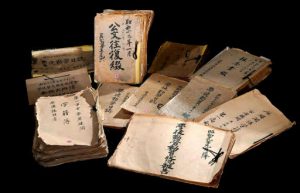Striving to fill voids in Hiroshima 76 years after the atomic bombing—Path to First Girls’ School tragedy
Jul. 19, 2021
Funairi High School has archived large volume of official documents and records related to student mobilization work
On July 18 it was learned that Funairi High School, located in Hiroshima’s Naka Ward, has archived numerous official documents related to student mobilization work and daily records of student activities of its predecessor school Hiroshima First Municipal Girls’ School (First Girls’ School). The documents serve as an important primary source of information for understanding the issue by which the First Girls’ School, obediently following the directions calling for enhancement of the student mobilization effort from the prefectural government and the Japanese military, became the school with the most A-bomb victims of all the prewar junior high schools and girls’ schools in Hiroshima City.
Most of the documents are dated between 1943 and 1945, including official correspondence containing about 400 notes, such as notices to schools from the prefectural government requesting the expansion of student mobilization efforts, in addition to about 30 other items such as booklets of reports that the First Girls’ School submitted to related organizations and daily records of student mobilization work written by the teachers who supervised the groups. Also included in the archived materials are school attendance registers of first-year and second-year students who died in the atomic bombing.
Most of the documents that have been stored on shelves in the principal’s office and the school library are not available to the public. The Hiroshima Prefectural and Hiroshima City governments do not have the series of documents, as their buildings were totally destroyed by fire after the atomic bombing of the city. Chie Shijo, associate professor at Hiroshima City University’s Hiroshima Peace Institute, points out, “They are regional intellectual resources by which verification is possible of how the school became militarized and cooperated in mobilizing its own students.” Conversely, “daily school records” and “student survey sheets,” into which teachers took turns making entries about the situation after the atomic bombing, are said to have been missing for several years.
“The materials are valuable for our school. Considering the storage conditions, however, we will likely need to talk with alumni in the future about entrusting them to a public institution,” said Tomoko Yanagi, principal of Funairi High School.
First Girls’ School lost a total of 676 students and staff in the atomic bombing of the city carried out by the U.S. military 76 years ago, including 541 first- and second-year students who were mobilized to demolish buildings for the creation of fire lanes.
(Originally published on July 19, 2021)








